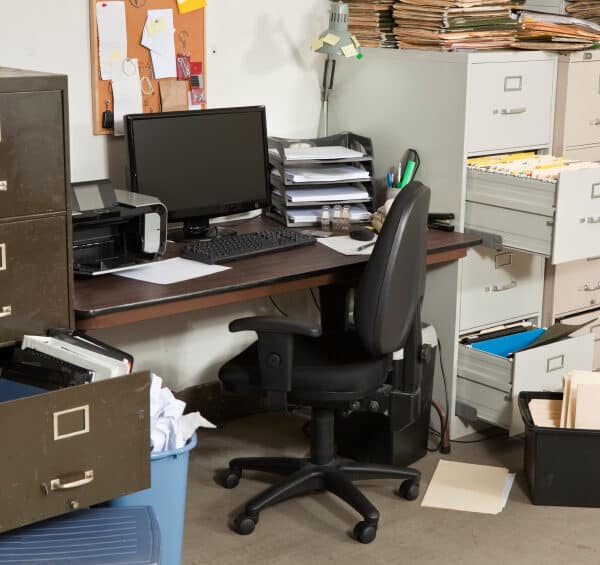 One in five admits having clutter
One in five admits having clutter
We are a nation of hoarders, and one in five of us admit to having enough clutter to fill a whole room! A survey, by market research group ICM, revealed that one in 20 of us has tripped over unwanted clutter at home; men are more ruthless than women when it comes to annual clear outs; and almost half of us hold on to clutter because it’s a hassle to get rid of. The worst culprits are the over 65s, with one in 10 overwhelmed by the number of items in their home, and one in 20 admitting they have tripped over clutter.
Very often such people create clutter in their workplace, which causes an obvious health and safety hazard, stress for others who are particularly tidy, and eventually a big problem when it comes to storage.
Keep it clear
During their visits, the CQC inspection team will check cupboards, drawers and any other hiding place in which we may storing paperwork, equipment and items we’ve had for decades, keeping them ‘just in case’! There’s often no need for us to keep that pack of carbon paper or bundle of patient leaflets that have been sitting in the cupboard since they were ordered 15 years ago. When carrying out fire risk assessments it’s often recognised that we keep far too much paper on site. It is worth investing the time to have a really good clear out, and I’m sure most will be amazed just how many of the items we have gathering dust on shelves that can be safely disposed of quickly and easily.
What about confidential records?
We are supposed to be working towards a paperless, or at least a paper-light status but, with ever increasing reporting, it is often difficult to find space to store confidential information. It is beneficial to scan and store information electronically, but what if you are in need of creating more storage space or more room space in general? There are various solutions, including creating more storage space by de-cluttering current storage space and making it lockable, or considering offsite storage.
Companies offering this service claim off site records storage and management can help to ‘lower operating costs, improve employee productivity, create more value from information assets, and protect organisations from the risks of litigation, audit, and disaster’. Some even claim that ‘records management and archiving off-site records storage programs have helped businesses and organisations save up to 50 per cent by lowering costs associated with storage space, personnel, and records management’. Whilst serious consideration needs to be taken regarding the security of the records, how safely and effectively they are stored, and how quickly you can access them, it is an opportunity to safeguard your records and could be of benefit when planning for disaster recovery.
How it affects others
In a previous QCS blog, David Beckingham, QCS Expert Mental Health Contributor, explained the risk of excessive hoarding to people’s wellbeing, and even their mental health. This can affect ‘the hoarder’ and also the people working with ‘the hoarder’. As with anything, getting rid of clutter can be made incredibly simple: just go through your stuff, one cupboard, one drawer, or shelf at a time, and get rid of everything that isn’t absolutely essential, that you don’t need or use. Of course, simplifying a process like this isn’t very useful to many people who struggle with clutter.
Top tips for action
As our businesses grow, we seem to collect more and more things that were once useful but no longer seem to get used. Very often we collect equipment but can no longer use it because it is broken, has a missing part, or has been there so long that it has become a fixed asset! The good news is that there are ways that you can effectively de-clutter, and any compulsive hoarder can take something from these top tips:
- Don’t keep it in the first place. If you’ve received a bundle of promotional material that you know you’re not going to give to clinicians or put on display for patients then contact the sender and ask them to take it back and remove you from their distribution list. Otherwise, dispose of it by recycling if you can.
- Donate or recycle, if you can, the things you are getting rid of. Often someone else can make use of it.
- De-clutter for 10 minutes every day. Creating a daily habit of tidying up and de-cluttering where necessary will enable you to keep on top of things. Try to do it just before you go home, that way you’re more likely to keep it to 10 minutes and will mean you’ve achieved something positive by the end of the day.
- Have a systematic approach if you need to do a big de-clutter. Aim to de-clutter one drawer or cupboard each week and work your way around the rest of the room.
- De-clutter one room at a time. If it’s a team effort, this should take no time to complete.
- Have at least two people to de-clutter each room. Just one person may feel emotionally attached to some of the items and is therefore less likely to get rid of them.
- Whenever you’re stood by the kettle, waiting for it to boil, open just one cupboard and give it a quick tidy up. Create a chart if you like and ask every member of staff to tick off which cupboard they’ve tidied, so that it’s a team effort. It might be a bit like painting the Forth Bridge, but at least it will get done regularly.
- Remember, when you open a cupboard or drawer and don’t know what’s in there, or cannot see what’s at the back, then it’s time to de-clutter!






